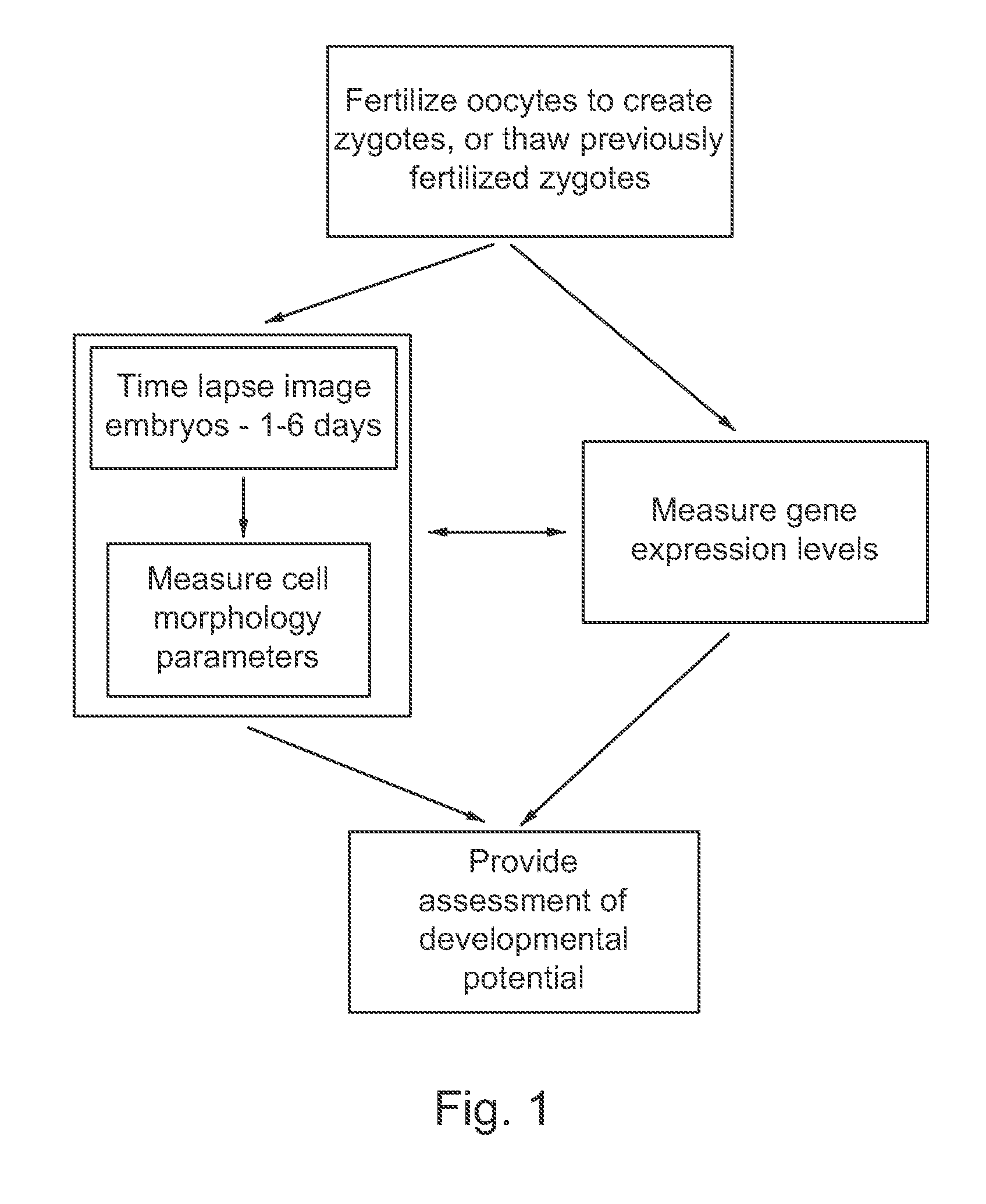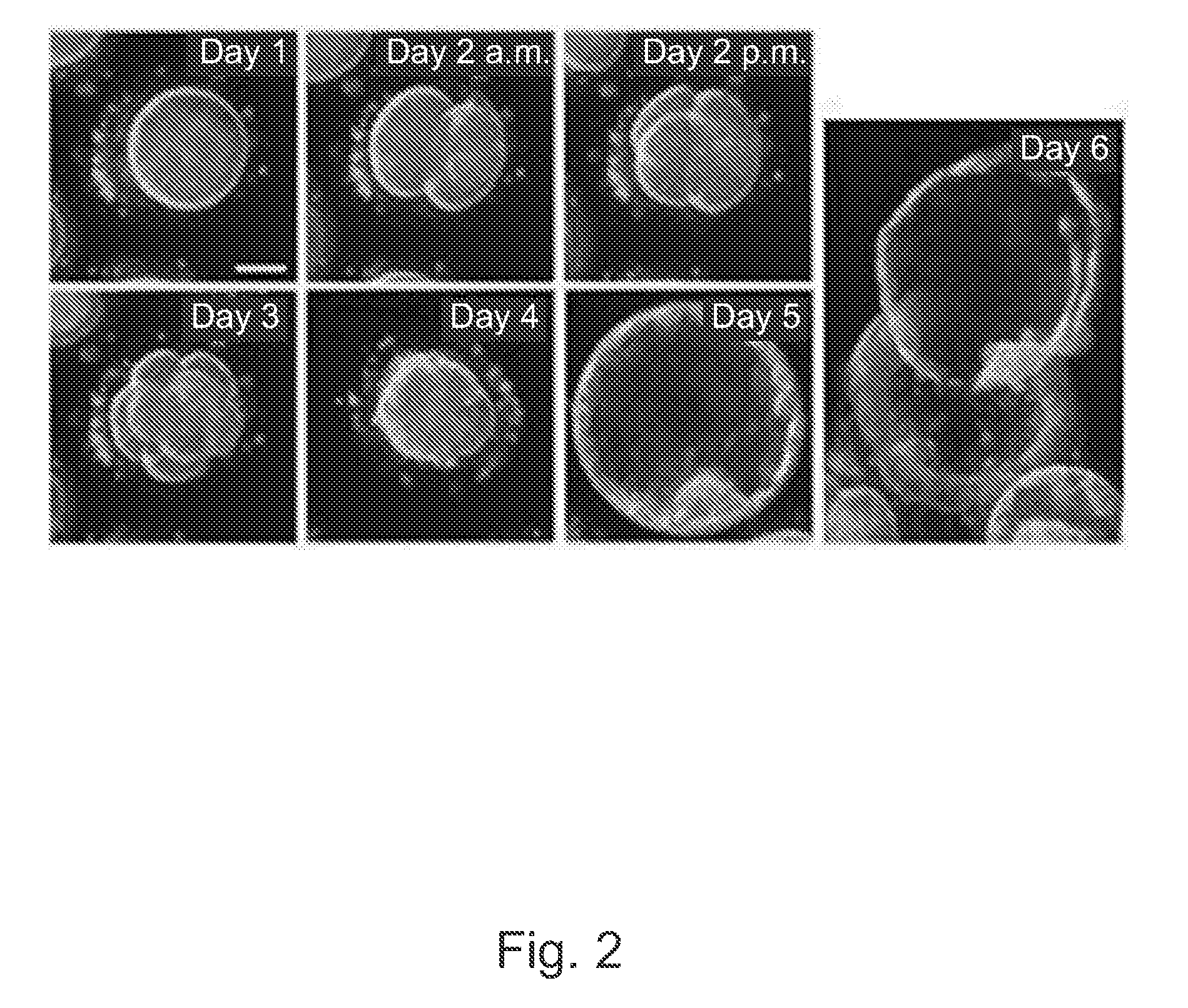Imaging and evaluating embryos, oocytes, and stem cells
a technology of embryos and stem cells, applied in the field of biological and clinical testing, can solve the problems of low birth rate, miscarriage, and well-documented adverse outcomes for both mother and fetus, and achieve good developmental potential, good developmental potential, and good developmental potential
- Summary
- Abstract
- Description
- Claims
- Application Information
AI Technical Summary
Problems solved by technology
Method used
Image
Examples
example 1
[0167]Imaging analysis to determine developmental potential of embryos.
Methods
[0168]Frozen 1-cell human embryos, also referred to as zygotes, were thawed and placed into culture and cultured under conditions such as those used in IVF procedures. As described in more detail above, these embryos appear to be representative of the typical in vitro fertilization (IVF) population as they were frozen at the 2PN stage and thus indiscriminately cryopreserved. This is in contrast to embryos typically cryopreserved at later stages of development following transfer of those perceived to be of the highest quality during fresh cycles. For some experiments, embryos were placed in a standard culture dish. For other experiments, embryos were cultured in custom culture dish with optical quality micro-wells.
[0169]The growing embryos, typically between 1 to 30 per dish, were followed individually by time lapse imaging with a computer controlled microscope equipped for digital image storage and analysi...
example 2
[0178]Validation of imaging parameters through gene expression analysis, and use of gene expression analysis to determine developmental potential.
Methods
[0179]Frozen 1-cell human embryos, also referred to as zygotes, were thawed and placed into culture and cultured under conditions such as those used in IVF procedures. For some experiments, embryos were placed in a standard culture dish. For other experiments, embryos were cultured in custom culture dish with optical quality micro-wells.
[0180]Embryos were removed from the culture and imaging system and collected as either single embryos or single cells (blastomeres) for gene expression analysis. Each plate typically contained a mixture of embryos, with some reaching the expected developmental stage at the time of harvest, and others arresting at earlier developmental stages or fragmenting extensively. Those that reached the expected developmental stage at the time of harvest were classified as “normal”, whereas those that arrested w...
example 3
[0195]Imaging oocyte maturation and subsequent embryo development.
Results
[0196]One of the major limitations of current IVF procedures is oocyte quality and availability. For example, current IVF protocols recruit oocytes from the small cyclic pool, providing a small number of oocytes (e.g. 1-20) for fertilization. Moreover, approximately 20% of oocytes retrieved following hormone stimulation during IVF procedures are classified as immature, and are typically discarded due to a reduced potential for embryo development under current culture conditions.
[0197]One method to increase the oocyte pool is through in vitro maturation. FIG. 14 shows three stages of development during in vitro maturation, including germinal vesicle, metaphase I, and metaphase II. The germinal vesicle and metaphase I stages are classified as immature oocytes, while metaphase II is classified as mature due to the presence of the first polar body, which occurs at 24-48 hours after initiating in vitro maturation. F...
PUM
| Property | Measurement | Unit |
|---|---|---|
| time | aaaaa | aaaaa |
| time | aaaaa | aaaaa |
| time- | aaaaa | aaaaa |
Abstract
Description
Claims
Application Information
 Login to View More
Login to View More - R&D
- Intellectual Property
- Life Sciences
- Materials
- Tech Scout
- Unparalleled Data Quality
- Higher Quality Content
- 60% Fewer Hallucinations
Browse by: Latest US Patents, China's latest patents, Technical Efficacy Thesaurus, Application Domain, Technology Topic, Popular Technical Reports.
© 2025 PatSnap. All rights reserved.Legal|Privacy policy|Modern Slavery Act Transparency Statement|Sitemap|About US| Contact US: help@patsnap.com



